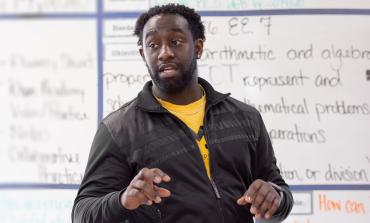Educating the next generation has always been one of America’s highest priorities. At the same time, educators have never been treated in a way that matched the importance of education. Underpaid, under-respected, often with challenging conditions. Yet those who become educators and stay in education do so because of a burning desire to make a difference in the lives of children. That is what sustains the thousands of AFT teachers and school staff I meet and talk with each year.
Unfortunately, the pandemic, combined with the political culture wars, has made the last two years the toughest in modern times for educators. And then, on top of all of that, the unthinkable happened again, when gun violence took the lives of 19 students and two teachers in Uvalde, Texas. These crises are piling on top of the tough conditions that teachers and school staff have been struggling with for years. For a long time, teachers and school staff have lacked the climate, culture, conditions, and compensation to do their jobs.
Every child deserves to have qualified, caring teachers and staff—people who are excited to work with them every day and dedicated to giving them a rich, joyful education. You can’t have a strong democracy and a strong economy without an engaged, informed, well-educated citizenship. Public school staff and educators are literally the builders of democracy.
Plus, our students really need their teachers and school staff around them right now. They need that stability. Children and their families are struggling. The COVID-19 pandemic caused untold grief, trauma, and economic hardship to many Americans. At a time when teachers and school staff are so vital in helping our children and communities recover and heal, untenable conditions are driving educators away.
That is why the AFT brought together one of the most important task forces we have ever convened in our history: the AFT Teacher and School Staff Shortage Task Force. We need to listen to the people who work in schools every day, the people who are closest to the issues that are driving teacher and school staff shortages. They can guide us to solutions.
Our task force brought together 25 leaders from AFT state and local unions across the country. They worked intensively with leading researchers in the field; they surveyed our membership and sought frontline input from many of AFT’s 1.7 million members.
What teachers and school staff are saying is that if conditions change, they will stay. That’s because every day, they see it as their mission to come to work and nurture, love, teach, and protect our kids.
So, the AFT task force thought big and bold. It envisioned our schools to be student-centered and educator-led where talented, dedicated people want to come and stay in education. They confronted, rather than complained about, the challenges facing our schools—challenges that have gone unresolved for so long and have negatively impacted teaching and learning, particularly for communities of color and communities that have been long shortchanged. The recommendations proposed here understand the need to rewire the many years of poor policy and decision-making that have led to this point and to reflect the realities being faced by students, teachers, and staff each day. Only then will our nation have schools where teachers want to teach, students want to learn, and parents want to send their children.
–AFT President Randi Weingarten
Even before the COVID-19 pandemic, nurses, guidance counselors, teachers, support staff, and bus drivers were facing disrespect and de-professionalization, stress and lack of support, low pay relative to other professions, and daunting workloads. Many educators are leaving long before they had planned, and the number of people entering the profession has plummeted. These shortages and the conditions contributing to them imperil the future of public education, the quality of the education our children receive, and our democracy itself. The AFT is not just studying the problem; we have laid forth in Here Today, Gone Tomorrow? specific remedies necessary to address this crisis.
The educator shortage is a challenge in both recruitment and retention. Students see the struggles of educators, hear all the negative attacks, and learn about the lack of political and financial support teachers and schools receive. Students also see educators choose other professions where they know they might get more respect, higher pay, better working conditions, and increased opportunities for career growth.
Those same factors cause teachers and other school staff to find other careers. Losing so much expertise has an enormous negative impact on students’ education and equity of learning opportunity. The financial consequences are also steep—more than $2 billion annually.
A majority of states report teacher shortages in math, science, career and technical education, special education, and bilingual education. Yet another area of shortage is in the diversity of educators. The teaching workforce is overwhelmingly white and growing less representative of the students they teach, a majority of whom are now students of color. We know that all students benefit from a diverse workforce. The opportunity to learn from different perspectives is valuable to all, and in particular, students of color benefit from having teachers with shared backgrounds and cultures. However, we do not do enough to attract and retain a diverse workforce of teachers and educators.
This is a crisis, and we cannot continue to let policymakers ignore it. Developing creative ways to recruit the best candidates, and then keeping these teachers and other personnel in our schools, must be a priority for our union, for superintendents and school boards, and for policymakers at all levels.
We need to reignite the passion that many have for entering the education profession, not extinguish it. We must change how teachers and other school professionals are treated and supported. Schools need to be places where adults and children alike can thrive and grow, where there are relationships built on trust and respect, and where partnerships exist among students, educators, families, and communities. Teachers and support staff need to be compensated adequately for the work they do and on par with other similarly educated professionals. Working conditions must be improved to make schools safe and welcoming places for everyone, where students and educators alike can feel successful. Teachers need career pathways that allow them to grow within their profession without having to leave the classroom. Paraprofessionals need the opportunity to develop their careers through pathways into teaching. Educators need opportunities to connect with parents and families to build relationships to support each other for the benefit of all children.
Vision for a New Era of Schooling
Schools are the centers of neighborhoods and communities, and it is detrimental to our students and staff when top-down decisions on schools are made without consideration of or by the people in the schools. In the last century, people who work in schools have changed, those who are educated in schools have changed, and the desired outcomes of schooling have changed. Yet, we have done very little to change the structure of schools on a wide scale. School structures in all US schools must move from outdated factory models and become modern and professional organizations. Schools, in partnership with all stakeholders, must be the learning and cultural centers of their communities.
Student-Centered Schooling
Schools first and foremost are for student learning, and we must look at how to restructure schools and the school day in a way that focuses on students rather than on accountability, money, or meeting arbitrary standards set by people who have never worked with children. Schools need to be places where all students can go to learn, grow, and be respected.
Teachers must be able to teach students honest history so that all students feel valued and schools are places of acceptance and tolerance. Teachers should be able to assess their students in a more holistic way, such as through project-based learning, rather than through standardized tests. Counselors, nurses, social workers, and other support staff need to be included in teams that work on interventions or other aspects of student learning. All school staff need supports and trust to develop positive relationships with students and families.
Educational equity is a challenge in a locally funded schooling system. Some students need more or different supports to overcome the additional challenges they face in their lives, and reforms must shift the distribution of resources and educators to ensure that all school systems are rooted in meeting the needs of all students.
Educator-Led Schooling
We cannot put a bandage on the teacher and school staff shortage by cutting corners and lowering the bar for entry. We must simultaneously raise entry standards, improve the way we treat workers, and improve recruitment and retention issues. To do this, we must give educators a larger voice in their work and allow them to have oversight of their profession just like lawyers and doctors. Research indicates that when teachers have more control over their social and instructional roles, there is less turnover. And less teacher turnover is good for students.
Educators are dissatisfied with poor working and learning conditions, but also with the de-professionalization that has stripped them of their freedom to teach. Teachers are not given the time or the trust to do what they need to do for their students. The outdated obsession with standardized testing created a broken system where teachers are overwhelmed with test preparation and collecting and reporting on data that do not help their students.
All children deserve to have people in their schools who are well-trained, well-supported, and excited to work with them every day. We need an overhaul in all aspects of the profession to ensure people want to enter and stay in school careers. The future of public education depends on it; the future of our democracy depends on it.
The charge of the task force was simple, but implementation of the recommendations will be far from easy. Here Today, Gone Tomorrow? represents a road map of solutions and actions stakeholders must take to reverse the trajectory of working and learning in America’s schools. It is a comprehensive approach to ensuring all schools are places where teachers want to teach, students want to learn, and parents want to send their children.
The challenges and recommendations identified in this report reflect the experience and expertise of the task force, made up of AFT state and local leaders representing more than 500,000 members; AFT members directly consulted through listening sessions in locals across the country and a nationally representative survey; and top education researchers who provided data and analysis. The task force debated numerous recommendations and possible steps needed to address the problems and assigned implementation strategies to all levels of government and to unions themselves.
This report stands as recognition that teacher and school staff shortages have been caused by a long-term disinvestment in schools, and there is not one simple solution to restructuring the school system to reflect the needs of its workers and learners. It stands as an acknowledgment that all students, and all educators and staff, have unique needs. As we move into the new school year, and throughout the next few years, the AFT will continue to use this report and its action steps to proactively improve the working and learning conditions for everyone in our schools.
[Photos: Allison Shelley for EduImages]


